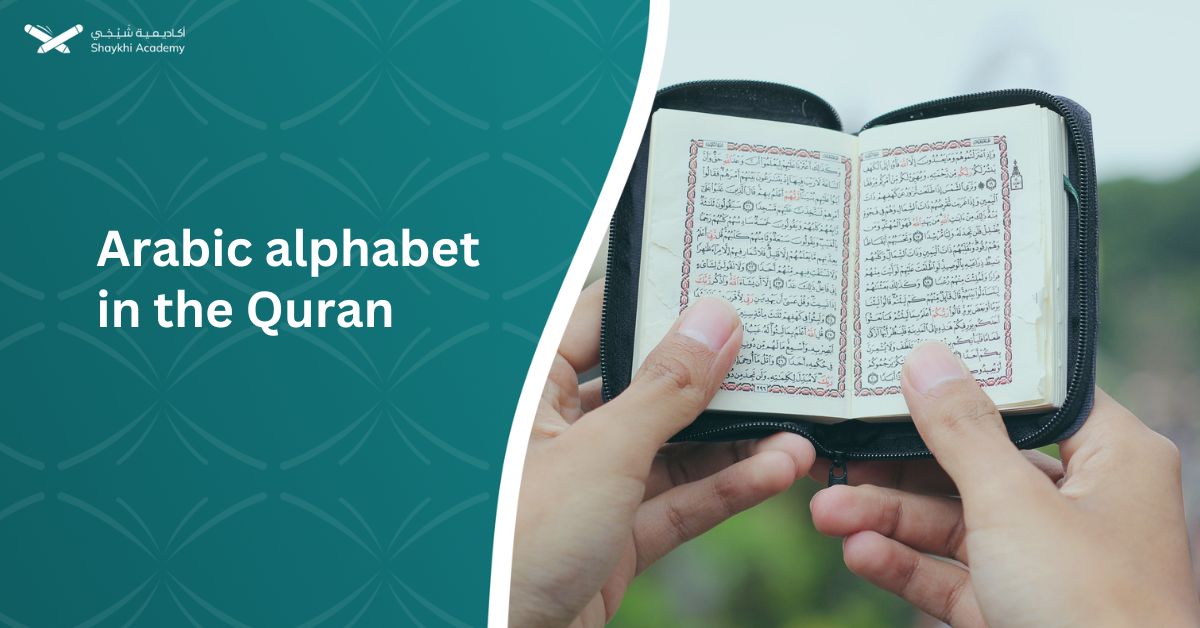The Arabic alphabet in the Quran comprises 28 letters, each with its own shape and sound. These letters are utilized in verses throughout the Quran, showcasing the linguistic richness and divine significance of the Arabic alphabet. Verses like those in Surat Al-Fath and Surah Al Imran contain all the Arabic letters, highlighting their comprehensive presence within the Quran.
It’s known that Arabic is the language of the Quran and since the Holy Quran was revealed in the Arabic language, the alphabet used in it is the Arabic alphabet with its letters.
The Holy Quran uses classical Arabic, which has great style and perfectly controlled pronunciation movements.
God honored the Arabic alphabet in many places in the Holy Quran. He used to swear by it, as we find at the beginnings of a number of surahs, including Surat Al-Baqarah and Surat Maryam.
Surat Al-Baqarah begins with the Almighty saying, “الم” which are letters from the Arabic alphabet, In the same vein Surat Mariam begins with the almighty saying “كهيعص” and these are also Arabic letters.
Arabic alphabet in the Quran
In the Quran, the Arabic alphabet consists of 28 letters, each with its own unique shape and sound. While some letters may appear similar, they are distinguished by dots or diacritical marks. The Quranic Arabic alphabet adheres to classical Arabic rules, exhibiting precise pronunciation movements and Tajweed guidelines.
Verses within the Quran showcase the entirety of the Arabic alphabet, such as verse 29 of Surat Al-Fath and verse 154 of Surah Al Imran. These verses contain all the Arabic letters, affirming the comprehensive utilization and divine significance of the Arabic alphabet within the Quran.
How many Arabic letters are in the Quran?
Considering that Arabic is the language of the Quran, then the alphabet used in the Quran is the Arabic alphabet, which includes 28 letters which are (أ – ب – ت – ث – ج – ح – خ – د – ذ ر – ز – س – ش – ص – ض – ط – ظ – ع – غ – ف – ق – ك – ل – م – ن – ه – و – ي), each of them has its own shape and sound.
You may find that some of the Arabic letters have similar shapes but for sure they are differentiated through dots or diacritical marks.
Quran alphabet Arabic
As we mentioned, the Holy Quran was revealed in Classical Arabic, which uses an alphabet consisting of 28 letters like modern Arabic.
What is distinctive about the Quranic Arabic alphabet is that it has a number of vowels and sounds that differ from the pronunciation of modern Arabic, and this is due to the Tajweed rules (Tajweed Alphabet).
The grammatical rules in the Arabic language are based on the Holy Quran. It is a branch of a large origin, so whoever wants to learn the original Arabic must learn Quranic Arabic.
Which Ayat has all Arabic alphabets in it?
There are verses in the Holy Quran that contain all the Arabic letters, such as:
- verse 29 of Surat Al-Fath
In this ayah God Almighty says:
مُحَمَّدٌ رَّسُولُ اللَّهِ وَالَّذِينَ مَعَهُ أَشِدَّاءُ عَلَى الكُفَّارِ رُحَمَاءُ بَيْنَهُمْ تَرَاهُمْ رُكَّعاً سُجَّداً يَبْتَغُونَ فَضْلاً مِّنَ اللَّهِ وَرِضْوَاناً سِيمَاهُمْ فِي وَجُوهِهِم مِّنْ أَثَرِ السُّجُودِ ذَلِكَ مَثَلُهُمْ فِي التَّوْرَاةِ وَمَثَلُهُمْ فِي الإِنجِيلِ كَزَرْعٍ أَخْرَجَ شَطْأَهُ فَآزَرَهُ فَاسْتَغْلَظَ فَاسْتَوَى عَلَى سُوقِهِ يُعْجِبُ الزُّرَّاعَ لِيَغِيظَ بِهِمُ الكُفَّارَ وَعَدَ اللَّهُ الَّذِينَ آمَنُوا وَعَمِلُوا الصَّالِحَاتِ مِنْهُم مَّغْفِرَةً وَأَجْراً عَظِيما.
- Verse 154 of Surah Al Imran
God almighty says:
ثُمَّ أَنزَلَ عَلَيْكُم مِّن بَعْدِ الْغَمِّ أَمَنَةً نُّعَاسًا يَغْشَى طَائِفَةً مِّنكُمْ وَطَائِفَةٌ قَدْ أَهَمَّتْهُمْ أَنفُسُهُمْ يَظُنُّونَ بِاللَّهِ غَيْرَ الْحَقِّ ظَنَّ الْجَاهِلِيَّةِ يَقُولُونَ هَل لَّنَا مِنَ الأَمْرِ مِن شَيْءٍ قُلْ إِنَّ الأَمْرَ كُلَّهُ لِلَّهِ يُخْفُونَ فِي أَنفُسِهِم مَّا لاَ يُبْدُونَ لَكَ يَقُولُونَ لَوْ كَانَ لَنَا مِنَ الأَمْرِ شَيْءٌ مَّا قُتِلْنَا هَاهُنَا قُل لَّوْ كُنتُمْ فِي بُيُوتِكُمْ لَبَرَزَ الَّذِينَ كُتِبَ عَلَيْهِمُ الْقَتْلُ إِلَى مَضَاجِعِهِمْ وَلِيَبْتَلِيَ اللَّهُ مَا فِي صُدُورِكُمْ وَلِيُمَحِّصَ مَا فِي قُلُوبِكُمْ وَاللَّهُ عَلِيمٌ بِذَاتِ الصُّدُورِ
Look at these verses carefully and search for any letter of the Arabic language (أ – ب – ت – ث – ج – ح – خ – د – ذ ر – ز – س – ش – ص – ض – ط – ظ – ع – غ – ف – ق – ك – ل – م – ن – ه – و – ي)
You will find them all in it.
Master Arabic with Shaykhi Academy: Your Gateway to Fluency!
Are you eager to learn Arabic from the comfort of your home? Shaykhi Academy offers you the perfect opportunity to master Arabic, whether for Quranic studies, daily communication, or advanced understanding.
Why Shaykhi Academy?
- Expert Native Tutors: Learn from highly qualified native Arabic speakers.
- Flexible Scheduling: Tailor your classes to fit your busy life.
- Affordable Learning: Access top-quality education at a price that suits you.
- Global Access: Study from anywhere in the world.
Explore Our Arabic Courses:
- Noorani Qaida: Build a strong foundation in Quranic Arabic.
- Comprehensive Arabic Courses: Master the Arabic language, from beginner to advanced levels.
- Fusha Arabic Classes: Delve into Modern Standard Arabic, the key to understanding literature, media, and formal communication across the Arab world.
- Quranic Arabic Course: Enhance your connection with the Quran by learning the language in which it was revealed.
Start Your Arabic Journey Today! Whether you’re just starting or looking to deepen your knowledge, Shaykhi Academy is here to support your journey. Book your free trial now and begin your path to Arabic mastery!

Conclusion:
The Quranic Arabic alphabet is not merely a linguistic tool but a divine gift, representing the language through which the Quran was revealed. Its utilization in the holy text emphasizes the importance of language in understanding and interpreting the Quran’s teachings. Through precise pronunciation movements and Tajweed rules, the Arabic alphabet preserves the integrity and authenticity of the Quranic message. Thus, the Arabic alphabet stands as a testament to the linguistic and spiritual beauty of the Quran.

















































